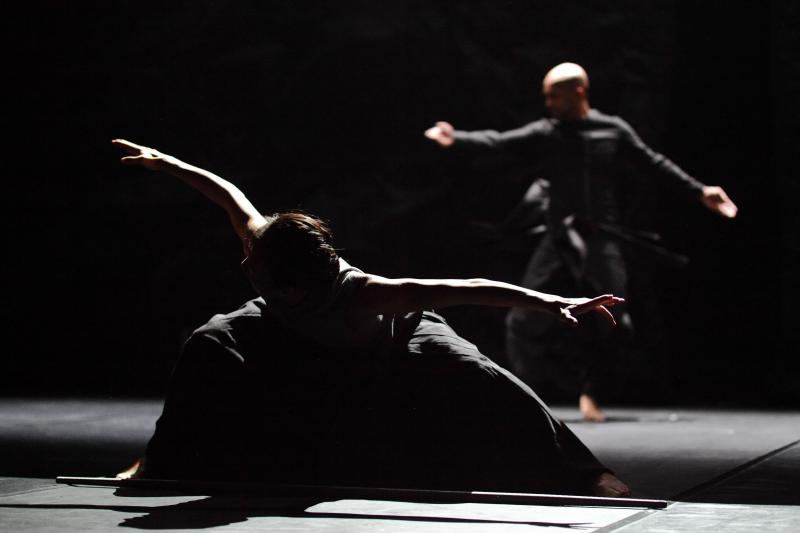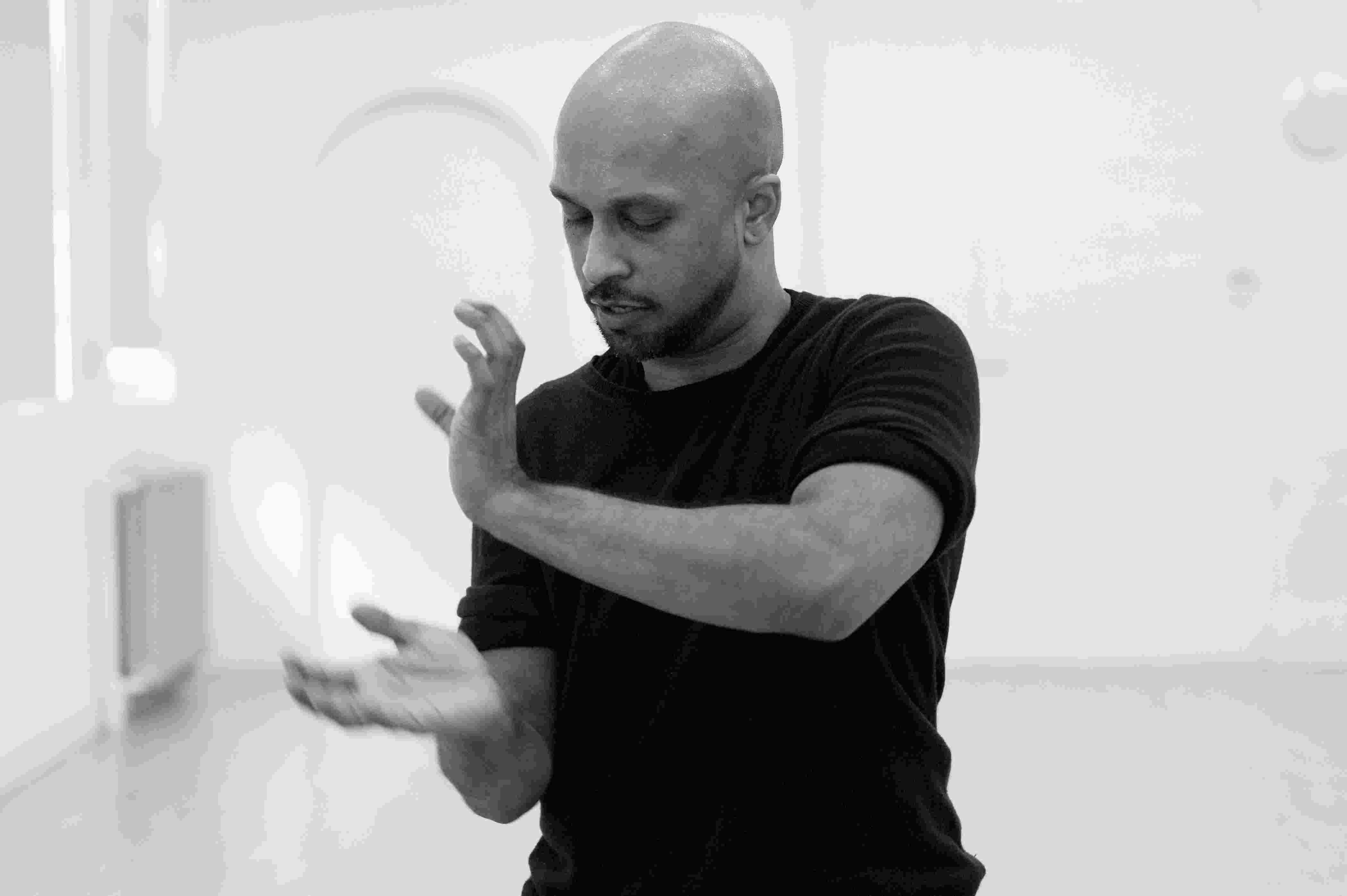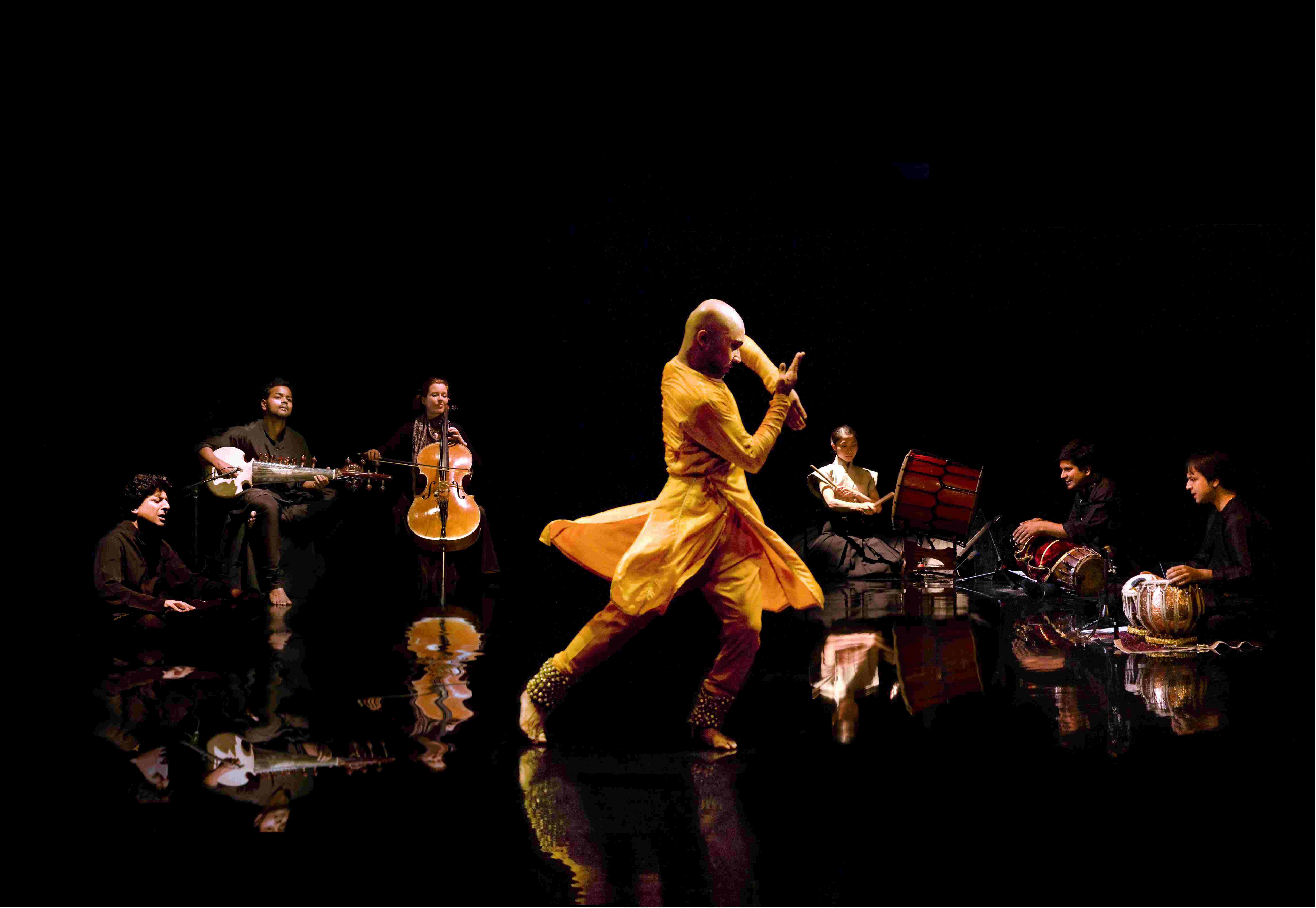Gnosis, Akram Khan, King's Theatre, Edinburgh | reviews, news & interviews
Gnosis, Akram Khan, King's Theatre, Edinburgh
Gnosis, Akram Khan, King's Theatre, Edinburgh
Gorgeous rhythm from Kathak legend

In keeping with the trends of recent years, the Edinburgh International Festival is showcasing a small but eclectic dance programme, light on classical ballet and heavy on contemporary, international and fusion. After choreographer Mark Baldwin’s collaboration with Ladysmith Black Mambazo last week, the festival is now playing host to what may be the final performances of Akram Khan’s bill Gnosis, which was a huge hit when it premiered at Sadler’s Wells in 2009.
 The first half starts with two long solos in the classical Kathak style, Polaroid Feet and Tarana. Khan dances with ghunghru bells on his ankles, and accompanied by six on-stage musicians. In Polaroid Feet, his hands are a marvel (pictured right), delicate and expressive as flowers following the light. In Tarana, Khan’s dancing seems to merge with the gorgeous singing of Koushik Aithal. It’s a sadness (as it is in flamenco) that most of us can’t understand the words, although both Aithal and Khan are such expressive storytellers that we are carried along anyway, rocked by the cadences of a narrative that is clearly poetic, heroic, and thrilling.
The first half starts with two long solos in the classical Kathak style, Polaroid Feet and Tarana. Khan dances with ghunghru bells on his ankles, and accompanied by six on-stage musicians. In Polaroid Feet, his hands are a marvel (pictured right), delicate and expressive as flowers following the light. In Tarana, Khan’s dancing seems to merge with the gorgeous singing of Koushik Aithal. It’s a sadness (as it is in flamenco) that most of us can’t understand the words, although both Aithal and Khan are such expressive storytellers that we are carried along anyway, rocked by the cadences of a narrative that is clearly poetic, heroic, and thrilling.
These two solos are followed by a little unplugged section, in which Khan and the musicians improvise. Khan’s stage presence is so potent, his dancing such a rich, polyphonous, almost supernatural form of communication, that his perfectly ordinary, rather gentle voice seems incongruously normal when he first takes to the microphone. With endearing warmth, he introduces the musicians and then tells us modestly that he and they are just going to throw some rhythms around, “a bit like a jam session”. What ensues is the most wildly fabulous ten (15? 60? I honestly have no idea) minutes. Beats cascade aross the stage, licking out from the percussionists to Khan’s feet and back in circles of ever-increasing complexity. Khan has talked of the mathematical nature of rhythm, and truly, it’s like being inside a fractal growing, as patterns constantly give rise to new patterns, returning ornamented and then heading off in new directions, all backed by the steady four beats of the base rhythm.
 Though it’s not especially loud, the beat gets under your skin and you become part of it, transported in one of the best non-drug-induced highs you can have in a room full of respectable theatre-goers. When I realised I was circling my ankle in time, I managed to pry my eyes off Khan’s mesmerically rapt face for long enough to observe that the stalls were subtly alive with rhythm: heads nodding slowly, shoulders swaying – the whole audience responding like a taut sounding board. It’s pure dance and pure sound combined: elemental, cleansing, unforgettable.
Though it’s not especially loud, the beat gets under your skin and you become part of it, transported in one of the best non-drug-induced highs you can have in a room full of respectable theatre-goers. When I realised I was circling my ankle in time, I managed to pry my eyes off Khan’s mesmerically rapt face for long enough to observe that the stalls were subtly alive with rhythm: heads nodding slowly, shoulders swaying – the whole audience responding like a taut sounding board. It’s pure dance and pure sound combined: elemental, cleansing, unforgettable.
After the interval (during which, ears still thrumming, I seemed to hear gorgeous percussion licks everywhere in the echoing corridors of the King’s Theatre), it requires some adjustment to return to the (slightly) more prosaic world of Gnosis, Khan’s story piece following two characters from the Indian epic, the Mahabharata. Fang-yi Sheu, a former principal dancer with the Martha Graham company, is Dhritarashtra, a king born blind, and Khan is Gandhari, who voluntarily blinds herself when she becomes his queen. Reversing the genders of performers and parts is dramatically effective, and also typical of Khan, who has a history of working with very powerful female dancers (Sylvie Guillem, Tamara Rojo).
Fang-yi’s opening solo showcases her strength with chalky downlighting that picks out her arm and shoulder muscles, and her stage presence builds to an almost unbearable intensity as she moves in silence for the first several minutes. It’s a relief when eventually the percussion kicks in and the solo becomes a thunderously powerful representation of ceremonial drumming. During the body of the piece I lost track of what exactly was supposed to be happening, but plenty of individual moments stood out: Fang-yi walking over Khan, or manipulating his limp body with her white stick, that is sometimes a blind person’s walking pole and sometimes a weapon, a fighting staff. The story ends with both of them dying in a forest fire, and both dancers deliver blistering solos in which their bodies become both flesh and flame, licking, flickering, contorting and finally coming to rest in stillness. There is a moment of stillness in the audience, too, before it breaks out into rapturous applause.
- Gnosis is at the King's Theatre, Edinburgh until 21 August. Details of dance at the Edinburgh International Festival can be found here.
The future of Arts Journalism
You can stop theartsdesk.com closing!
We urgently need financing to survive. Our fundraising drive has thus far raised £49,000 but we need to reach £100,000 or we will be forced to close. Please contribute here: https://gofund.me/c3f6033d
And if you can forward this information to anyone who might assist, we’d be grateful.

Subscribe to theartsdesk.com
Thank you for continuing to read our work on theartsdesk.com. For unlimited access to every article in its entirety, including our archive of more than 15,000 pieces, we're asking for £5 per month or £40 per year. We feel it's a very good deal, and hope you do too.
To take a subscription now simply click here.
And if you're looking for that extra gift for a friend or family member, why not treat them to a theartsdesk.com gift subscription?
more Dance
 'We are bowled over!' Thank you for your messages of love and support
Much-appreciated words of commendation from readers and the cultural community
'We are bowled over!' Thank you for your messages of love and support
Much-appreciated words of commendation from readers and the cultural community
 Peaky Blinders: The Redemption of Thomas Shelby, Rambert, Sadler's Wells review - exciting dancing, if you can see it
Six TV series reduced to 100 minutes' dance time doesn't quite compute
Peaky Blinders: The Redemption of Thomas Shelby, Rambert, Sadler's Wells review - exciting dancing, if you can see it
Six TV series reduced to 100 minutes' dance time doesn't quite compute
 Giselle, National Ballet of Japan review - return of a classic, refreshed and impeccably danced
First visit by Miyako Yoshida's company leaves you wanting more
Giselle, National Ballet of Japan review - return of a classic, refreshed and impeccably danced
First visit by Miyako Yoshida's company leaves you wanting more
 Quadrophenia, Sadler's Wells review - missed opportunity to give new stage life to a Who classic
The brilliant cast need a tighter score and a stronger narrative
Quadrophenia, Sadler's Wells review - missed opportunity to give new stage life to a Who classic
The brilliant cast need a tighter score and a stronger narrative
 The Midnight Bell, Sadler's Wells review - a first reprise for one of Matthew Bourne's most compelling shows to date
The after-hours lives of the sad and lonely are drawn with compassion, originality and skill
The Midnight Bell, Sadler's Wells review - a first reprise for one of Matthew Bourne's most compelling shows to date
The after-hours lives of the sad and lonely are drawn with compassion, originality and skill
 Ballet to Broadway: Wheeldon Works, Royal Ballet review - the impressive range and reach of Christopher Wheeldon's craft
The title says it: as dancemaker, as creative magnet, the man clearly works his socks off
Ballet to Broadway: Wheeldon Works, Royal Ballet review - the impressive range and reach of Christopher Wheeldon's craft
The title says it: as dancemaker, as creative magnet, the man clearly works his socks off
 The Forsythe Programme, English National Ballet review - brains, beauty and bravura
Once again the veteran choreographer and maverick William Forsythe raises ENB's game
The Forsythe Programme, English National Ballet review - brains, beauty and bravura
Once again the veteran choreographer and maverick William Forsythe raises ENB's game
 Sad Book, Hackney Empire review - What we feel, what we show, and the many ways we deal with sadness
A book about navigating grief feeds into unusual and compelling dance theatre
Sad Book, Hackney Empire review - What we feel, what we show, and the many ways we deal with sadness
A book about navigating grief feeds into unusual and compelling dance theatre
 Balanchine: Three Signature Works, Royal Ballet review - exuberant, joyful, exhilarating
A triumphant triple bill
Balanchine: Three Signature Works, Royal Ballet review - exuberant, joyful, exhilarating
A triumphant triple bill
 Romeo and Juliet, Royal Ballet review - Shakespeare without the words, with music to die for
Kenneth MacMillan's first and best-loved masterpiece turns 60
Romeo and Juliet, Royal Ballet review - Shakespeare without the words, with music to die for
Kenneth MacMillan's first and best-loved masterpiece turns 60
 Help to give theartsdesk a future!
Support our GoFundMe appeal
Help to give theartsdesk a future!
Support our GoFundMe appeal

Add comment